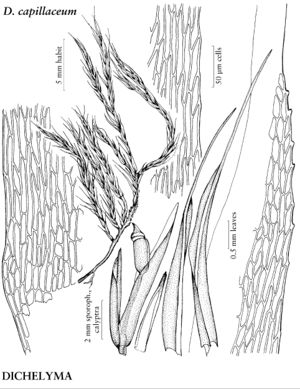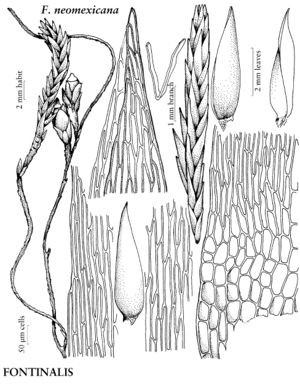Fontinalaceae
Plants small to large, in loose or dense masses. Primary-stems creeping. Secondary stems prostrate, pendent, or trailing, freely and irregularly branched; central strand absent; rhizoids on stems and at base of secondary stems, from initials abaxial to leaf insertions and around secondary stem primordia; axillary hairs elongate. Leaves 3-ranked, keeled, conduplicate, concave, or plane; base decurrent; margins entire or serrulate; costa subpercurrent to long-excurrent or nearly ecostate; alar cells enlarged and bulging or walls firm; medial laminal cells linear to linear-rhomboidal. Sexual condition dioicous; perigonia gemmate; perichaetia lateral on short branches. Seta short or elongate. Capsule immersed, laterally emergent, emergent, or exserted, oval, oval-oblong, subcylindric, or cylindric; stomata absent; annulus rudimentary or rarely massive; operculum obtuse-conic, acute, or obliquely rostrate; peristome diplolepidous; exostome teeth 16, linear, sometimes united in pairs at apices, external surface smooth, occasionally papillose or spiculose-papillose, lightly thickened, internal surface heavily thickened, granulose, sometimes obscurely striate, inner trabeculae heavily thickened; endostome segments linear, red to brownish orange, papillose, united by lateral bars only distally (trellis imperfect) or throughout (trellis perfect). Calyptra mitrate or cucullate, smooth, naked, sometimes clasping base of seta when young. Spores small or large, smooth to lightly papillose.
Distribution
North America, South America, Eurasia, Africa, Atlantic Islands (Iceland)
Discussion
Genera 3, species 19 (3 genera, 15 species in the flora).
Fontinalaceae are distinguished by the aquatic or semi-aquatic habitat, long axillary hairs, absence of stem central strand, lack of stomata, odd exostome morphology, and unusual trellised endostome. The exostome teeth in Fontinalaceae are linear, with outer and inner plates equally high. The endostome is firm rather than membranous because of relatively heavy secondary thickening.
All three genera and most species of Fontinalaceae are found in North America. Brachelyma, which is semi-aquatic with a strong single costa and occasional stem paraphyllia, appears to be the basal genus in the family. Fontinalis, on the other hand, is generally aquatic with a nearly absent costa, well-developed, often bulging alar cells, and immersed to short-emergent capsules, and it appears to be the most derived genus in Fontinalaceae.
Selected References
None.
Lower Taxa
Illustrations
Key
| 1 | Leaves ecostate or nearly so. | Fontinalis |
| 1 | Leaves with costae present | > 2 |
| 2 | Leaves oblong-lanceolate to lanceolate; calyptrae covering operculum only; setae0.7-1.5 mm; capsules immersed. | Brachelyma |
| 2 | Leaves lanceolate to linear-lanceolate; calyptrae covering capsule; setae 3-15(-20) mm; capsules immersed, emergent, or exserted. | Dichelyma |




